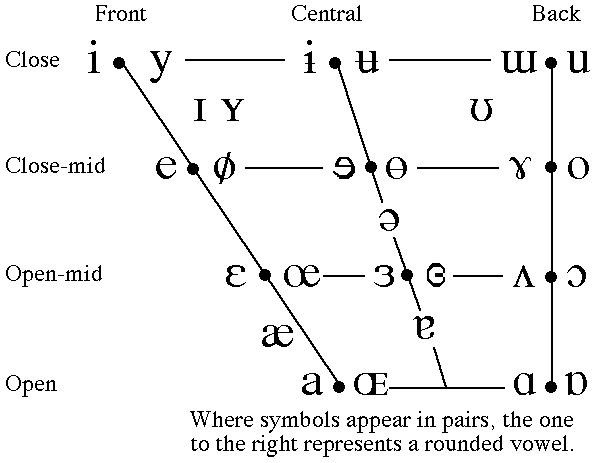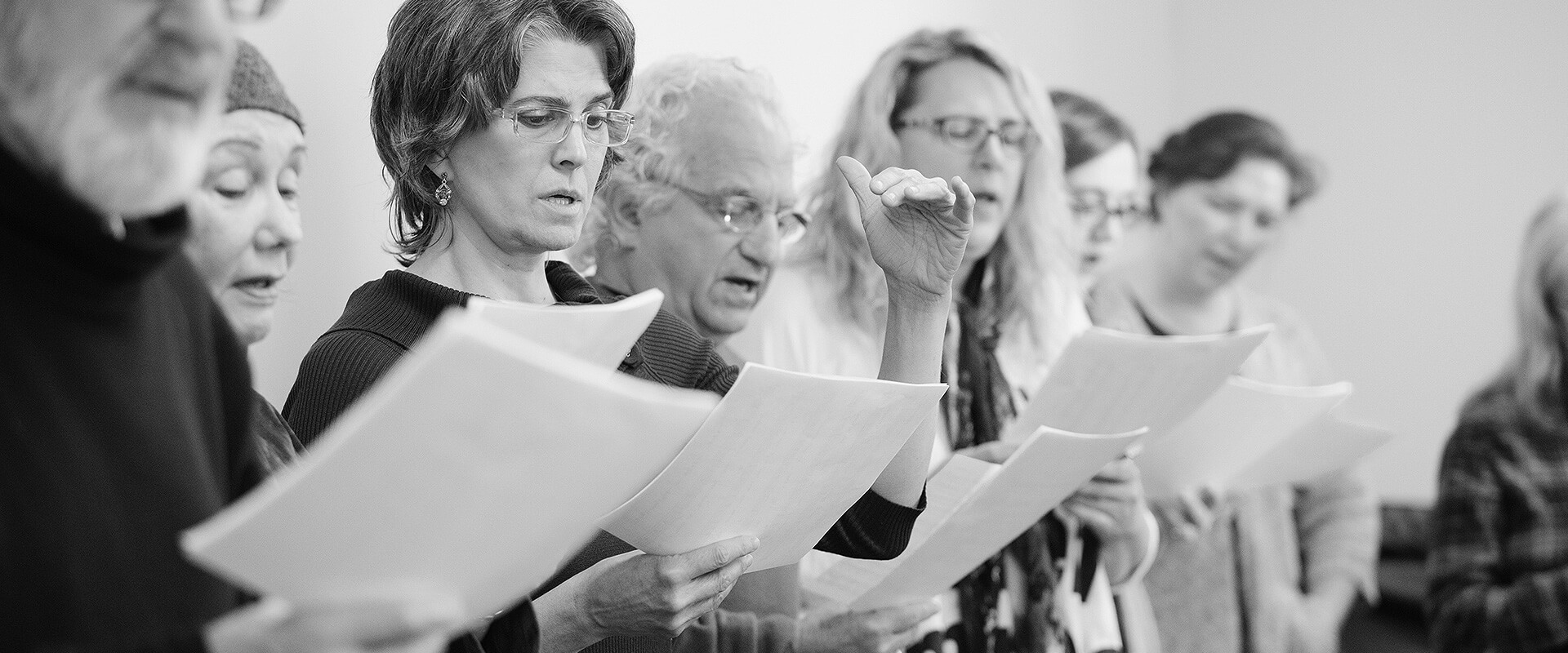Vowels
In singing we practice five main vowels, namely [i, e, a, o, u] although there are many more than that. (Please refer to the IPA vowel chart below.) Traditionally, vowels were practised sequentially in that same order. This allowed singers to start with a closed vowel [i] and finish with a closed vowel [u] while opening the mouth wider for [a] past the mid-vowel [e] on the way down and [o] on the way up. You might notice that [i, e, a] are listed as front vowels and [ɑ, o, u] are considered back vowels. In singing, all vowels must be considered forward in order to equalize the vowel qualities and get an unbroken vocal line. As helpful as this IPA chart is, it is also a bit misleading for singers who need to learn to pronounce the ‘back’ vowels as far forward as possible. Unfortunately the traditional order of vowels is not helpful either; it does not allow us to concentrate on training the tongue and the lips to be independent of each other and, more importantly, independent of the jaw. This last point is essential for singers as it permits you to anchor notes in all registers (see Anchoring), especially the upper-middle (important for pop singers) and upper registers (important for some pop and all classical singers). Regardless of the type of music you like to sing, vocalizing well and warming up all registers is needed to balance your speaking voice and improve your tone quality throughout your range.
Vowels can be subdivided more usefully for singers into two groups: tongue vowels and lip vowels, depending on the primary part used to articulate the vowel in question. Ah [a], ae [e], ee [i] are tongue vowels because they require the forward movement of the tongue (see Tongue). Ah [ɑ], oh [ɔ], o [o] and oo [u] are lip vowels as they require a forward movement of the lips (see Lips). This equalizing of quality is sometimes called ‘focusing’ the the vowels. Since focus is also used for a more general quality in the voice (see Phonation), its best to avoid this term.
In speech, the default position of your mouth is closed; in singing, however, it is open. This is quite a different point of reference which needs some careful consideration by singers of all musical styles, especially those aspiring to exquisite classical singing. The most open vowel is ah [a] so we always start with this one because it is the most relaxed and neutral for the tongue, lips and jaw.
If you practise the tongue vowels [a, e, i] starting from this neutral position, with the jaw hanging loosely open, you can then concentrate on having the tongue pronounce each vowel without closing your mouth or raising the jaw for [e] and [i]. The tongue merely rocks forward for each subsequent vowel, with the jaw remaining in its lowest position, hanging comfortably open, as in ah [a] or [ɑ]. Some students initially object, claiming it is an impossible task, but its not. Remember you are retraining the tongue to say these vowels under different circumstances. You will be using a new area of your tongue to say vowels you have pronounced well all your life; no one said it would be easy. Your tongue may feel like a foreign object in your mouth for a few weeks, but it will pass. Work with a mirror and do a few minutes each day until you get the hang of it. You can speak the vowels; there is no need to sing while doing this initially. It feels strange at first but you will progress if you keep the jaw still and force the tongue to move. Think a strong, pure vowel and the tongue will slowly adapt to these new constraints.
A similar approach is needed for lip vowels. You start with the neutral ah [a] and progress to oh [ɔ], ow [o] and oo [u]. Cheat the jaw down as much as possible for [o] and [u]. One trick is to add a small w on the release of the note which makes us hear the whole note as more closed. If you avoid closing the jaw in lip vowels, the lips will have to assume a more forward position to achieve a pure vowel. You need to move the corners of the mouth forward and closer together while keeping the centre of the top and bottom lips relaxed. This forward position of the lips should not affect the position of the jaw; forward lips, as in a trumpet-like shape, does not require the jaw to be forward as well. It should be hanging in its neutral position [a]. Another common error is that some singers tend to retract and/or lower the tongue for [o] and [u]. Make sure that the tip of the tongue is touching the lower front teeth for all vowels and that the back of the tongue is relaxed and relatively high as in an [a] vowel (see Tongue).
In tongue vowels, the lips need to remain relaxed. Their position determines whether the vowels are heard as spread or vertical. A spread vowel, such as a smiley ee [i], is very difficult to anchor more than a fourth or fifth above your speaking voice. Once you reach a major 6th above your speaking voice, losing the smiley aspect is essential for anchoring (see Anchoring). Physically move the corners of the mouth slightly forward if you have tongue vowels that are too spread. With practice, the fine muscles around your mouth will slowly learn how to do this without your direct intervention.
Since an open mouth is your default position while singing, it is helpful to recite the words of your songs in rhythm while practicing this open-mouthed technique. Put your three middle fingers on each cheek to assure that the jaw remains down and back. Recite all the vowel-consonant combinations with attention to the open-mouthed, hang-jaw position. You may close the jaw when needed for various consonants but make sure it returns to its open default position quickly for each vowel. The jaw needs to learn to drop straight and fast to its open, default position to achieve a uniform sound quality (see Jaw).
What is explained here, albeit very briefly, will transform your singing to a professional level faster than anything else I know of. As straightforward as I try to describe it, there are many details that cannot be conveyed in this format. Amateurs and professionals alike will benefit from this type of work as it provides a structure to approaching every song you sing, each with its own set of unique difficulties. It will definitely propel you to the next level; with one-on-one training and tailor-made techniques, you just get there faster.
International Phonetic Alphabet: Vowel Chart

For more information or to book a private lesson, please go to the contact page.
 Montreal Voice Coach
Montreal Voice Coach